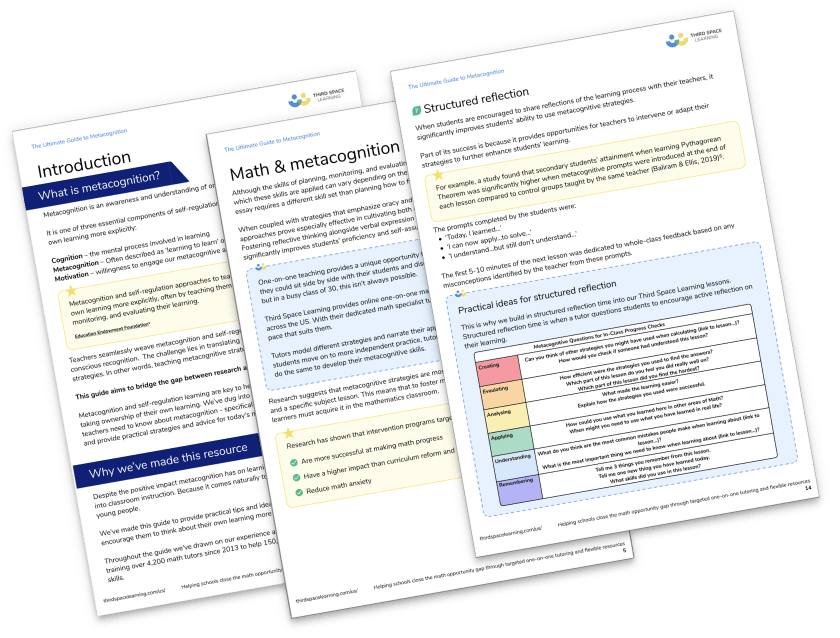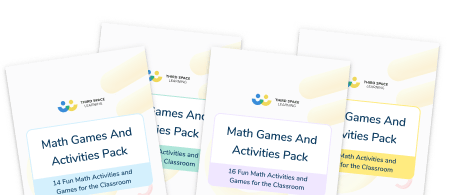How To Use Math Investigations To Develop Mathematical Reasoning At Any Age
When you think of math investigations, what do you conjure up in your mind? For me it’s about being a great detective, like Sherlock Holmes, and involves lots of consideration, examination, probing, scrutiny and studying.
The clues are all in the word. Invest + i + gate: I have to go through lots of doors and invest time searching for a solution. For students to work on a math investigation, they need to invest time and energy, alongside plenty of reasoning, problem-solving and collaboration with others.
12 Math Club Games and Activities
A collection of games and activities that are a great way to make math enjoyable in an elementary school math club!
Download Free Now!Math Investigations: The Detective Mindset
Children need to adopt the mindset and persona of a detective (like Sherlock Holmes) when ‘doing’ math.
When children do this, they take on board some of the essential characteristics needed to understand a ‘case’: they must have a keen eye for details and strong analytical skills. They need to work with the right strategy.
Sherlock was ruthless at collecting, analyzing and deducing information and that’s precisely what children need to integrate into their own ways of working.
Like him, children need to be ruthless in how they look for evidence and gather what data they can to help them solve a problem. The deductions they make need to be backed up with evidence.
Finding an answer is one thing but finding a solution is quite another and that means going through a process. An important intellectual skill is the nurturing of cognitive determination and investigations can support this by giving children contexts to express their thinking out loud.
The Math Investigation Mindset: Mathematical Detectives
Mathematicians are nothing special but their styles of thinking can make them appear this way. A key philosophy underpinning ‘math mastery’ is the growth mindset and this is also a key ingredient of the detective approach to math investigations.
Math mindsets have to be ‘open for business’ which means as teachers we need to provide a rich number of opportunities to allow for development. Every child has the potential for developing higher mathematical-logical intelligence, from 2nd grade to high school.
By using mathematical content students already know in new ways, you can develop important mathematical skills that might otherwise be left undeveloped.

Meet Skye, the voice-based AI tutor making math success possible for every student.
Built by teachers and math experts, Skye uses the same pedagogy, curriculum and lesson structure as our traditional tutoring.
But, with more flexibility and a low cost, schools can scale online math tutoring to support every student who needs it.
Find out more
How you can nurture a mindset ready to start your math investigations
In her book, Mathematical Mindsets, Jo Boaler argues that in order to promote a detective mindset for math, we need to:
- Support all learners to understand that they can learn anything and that struggle is the best time for brain growth
- Teach multidimensional math – ask children to represent ideas visually, numerically, graphically, verbally, algorithmically – color code and make connections between them
- Put the brakes on speed and celebrate depth and creativity
- Encourage and value multiplicity – all the different ways children think
- Help children to realize that they ‘can do’ math and that when they believe in themselves then their brains are more active and grow more.
Her suggestions are a great starting point for many schools, but there are more ways in which you can develop a good math investigation mindset in your math curriculum.
Practical ideas to lay the foundations of good math investigation work in your school
If your elementary school and school district already prizes curiosity and an investigative approach to learning then your students will already be at an advantage. Paced and supported appropriately you can start introducing math investigations early in elementary school or even in kindergarten.
Here are some ways in which you can lay those foundations
- Inspire awareness of numbers and shapes in the environments and how math is all around us.
- Teach and provide a variety of problem-solving strategies.
- Encourage children to work systematically.
- Provide a range of rich tasks so children can ‘get inside’ the mathematics.
- Use low-threshold high ceiling tasks
- Practice ‘guided math’, similar to ‘guided reading’.
- Encourage ‘flow-chart’ thinking and have students sequence steps when solving a puzzle.
- Give children opportunities to create categories for sorting and classifying.
- Promote the regular use of Venn diagrams for ‘graphical thinking’.
- Include lots of strategic math games.
- Get children to create and pose their own math problems (included open-ended problems).
- Extend knowledge or apply knowledge in new contexts.
- Make brainteasers a daily feature of math to train logical thinking.
- Let children work within intriguing contexts.
- Provide ideas for personal learning projects where children can explore, predict and experiment for themselves.
- Devote a part of the classroom to interactive puzzles, problems and posers.
- Push STEAM (Science, Technology, Engineering, Arts and Math) all the way so that children see and apply math across the curriculum.
- Provide opportunities for children to see other people being mathematical or see the role of math within different cultural settings.
- Promote a conjecturing atmosphere.
- Set up a range of ‘active assessment’ opportunities for collaborative dialogue rich talking tasks so children can explain, justify, verify, convince and refute.
- Promote a range of questions and prompts to fuel divergent thinking.
- Promote analogy, schematizing, defining and deduction.
- Give one or more counter-examples of a given concept.
- Provide math challenges to provoke children to clarify differences between related concepts.
- Encourage regular reflective ‘journaling’ so children can transcribe and draw their ideas into a learning log.
A cerebral culture that develops and places a high value on investigative intelligence must be the starting point for any classroom hoping to cultivate a detective mindset.
Deductive reasoning is one of the most valuable skills a child can have and so this is an essential component of any math investigative curriculum.
Mind benders, thoughts and crosses, logic puzzles, riddles – these all help to support this critical thinking faculty and help children see patterns, ask questions, learn and discover.
We’ve got lots more free teaching resources around real world math problems and problems based around events like World Book Day available in the blog as well as on our math hub if you want to explore further.
What children need to know before they start
The most important thing we can help children to do is learn how to weed out the important information from the superfluous in any math investigation.
In other words, they need to do what Sherlock would do and learn how to recognize vital facts from incidental facts.
Some investigations contain additional irrelevant information in their narratives that can throw children off the trail and it is this extraneous gunk that children should be trained to spot and bin. The power of observation is everything.
Weaning out the incidental facts from those that are relevant helps children crack the case. Knowing how to spot information and what is needed is the first step to becoming a sleuth math detective.
Nothing is useless unless you decide it is but identifying the importance of something is what children need to get good at. They need to consider everything and discard with efficiency.
Knowing how to sieve through the information and create a clear connection between numbers and words is the logical way to find a solution.
Children often mess up questions in tests because they aren’t paying attention to the finer details. They are trying to get things done quickly and because of that they either miss important information or focus on the smaller details that are ‘distractors’ or redundant and superfluous information. Cultivating new habits of slowing down and paying attention is vital.
A great habit to get children into is simply asking “Why is that there?” when looking at math investigations and test style questions.
Practice math investigations
To build these skills in students, try including some of these investigative math questions for elementary students in your next few lessons. Below, we have suggestions for different grade levels.
4th grade math investigations
- There are 29 chapters in a book and 45 pages per chapter. The average number of words per page is 500. How many pages in total?
- A packet of Cheesy Wonder snacks weighs 28g. There are 16 packets of the snack in a multipack costing $4.50. Samraaj buys 8 multipacks for his party. How many grams of snacks has he bought?
5th grade math investigations
- A pet food truck makes a 296 mile trip 56 times in 2 months. It’s average speed is 65 m/h. How far does the lorry travel in total?
- Miss Dickens, aged 22, needs to save $846 for her holiday to Miami. She saves $26 a week. How many weeks will it take to save enough money for her holiday?
- A pack of 32 cinnamon rolls weighs 1440g and costs $1.49. How much does one roll weigh?
Strategies for tackling any math investigation
If students struggle to know where to begin with investigative questions, you might want to try these techniques. After all, to successfully solve a problem, children need to know exactly what the problem is!
Children could try to:
- Draw a diagram
- Draw a table
- Act it out or use concrete material
- Guess and check
- Create an organized list
- Look for a pattern
- Create a tree diagram
- Work backwards
- Use simpler numbers
- Use logical reasoning and math strategies for problem solving
- Analyze and investigate
- Rephrase the question
Defining a problem and investigating a solution provides children with the chance to ‘do’ mathematics, to ‘make sense’ of their world and to ‘be mathematicians’.
When they discover ideas and invent procedures, children have a stronger conceptual understanding of connections between mathematical ideas.
Math investigations are for life, not just for Christmas
When children engage with investigative work they begin to see and appreciate the inner sanctum of and the true beauty of the subject. They can make inferences, get creative, challenge themselves and work with their peers and upgrade their own knowledge, understanding and skills.
We might assume that investigating, exploring and solving problems are central elements of the math lessons in every classroom but this sadly isn’t the case everywhere.
I know of some schools that ‘reserve’ the last week of every semester to a math investigation but this is frankly not enough.
Investigations aren’t booked in like a table for four in a restaurant as a special treat. Investigations need to be a regular feature of math work so that the key Sherlock skills are exercised regularly. You want to do more than awaken them every now and then, as some sort of add-on to satisfy an ‘added value’ tick-box.
There is always time for a math investigation because they can vary in length from just a few minutes to a whole lesson and beyond.
No time? No excuses – there is always time to build-in an investigation and the math mind palaces need stocking up as ‘empty shelves’ don’t solve problems.
Investigations come in all shapes and sizes and may be framed variously as: a question to be answered, a problem to be solved; a task to be accomplished, or an issue to be explored.
Who says that an investigation has to be a whole lesson? It doesn’t. It could be something you start in the morning and finish in the afternoon.
Micro investigations can be some open-ended questions that have no one right answer or it could mean finding the same solution using different routes and pathways.
Small-scale investigations might involve similar open-ended questions but as part of a more complicated context. Macro investigations can involve a range of math skills and concepts and be used as an ongoing teaching tool throughout the year that step by step scaffolds understanding.
Investigations are involving and interesting activities that absorb children. They stimulate holistic thinking, they can be integrated naturally in every part of the curriculum, they promote complex thinking but reinforce basic concepts, and they constitute an essential part of every mathematician’s work.
Read more
Do you have students who need extra support in math?
Skye—our AI math tutor built by experienced teachers—provides students with personalized one-on-one, spoken instruction that helps them master concepts, close skill gaps, and gain confidence.
Since 2013, we’ve delivered over 2 million hours of math lessons to more than 170,000 students, guiding them toward higher math achievement.
Discover how our AI math tutoring can boost student success, or see how our math programs can support your school’s goals:
– 3rd grade tutoring
– 4th grade tutoring
– 5th grade tutoring
– 6th grade tutoring
– 7th grade tutoring
– 8th grade tutoring
The content in this article was originally written by Ofsted inspector and teacher John Dabell and has since been revised and adapted for US schools by elementary math teacher Christi Kulesza.







